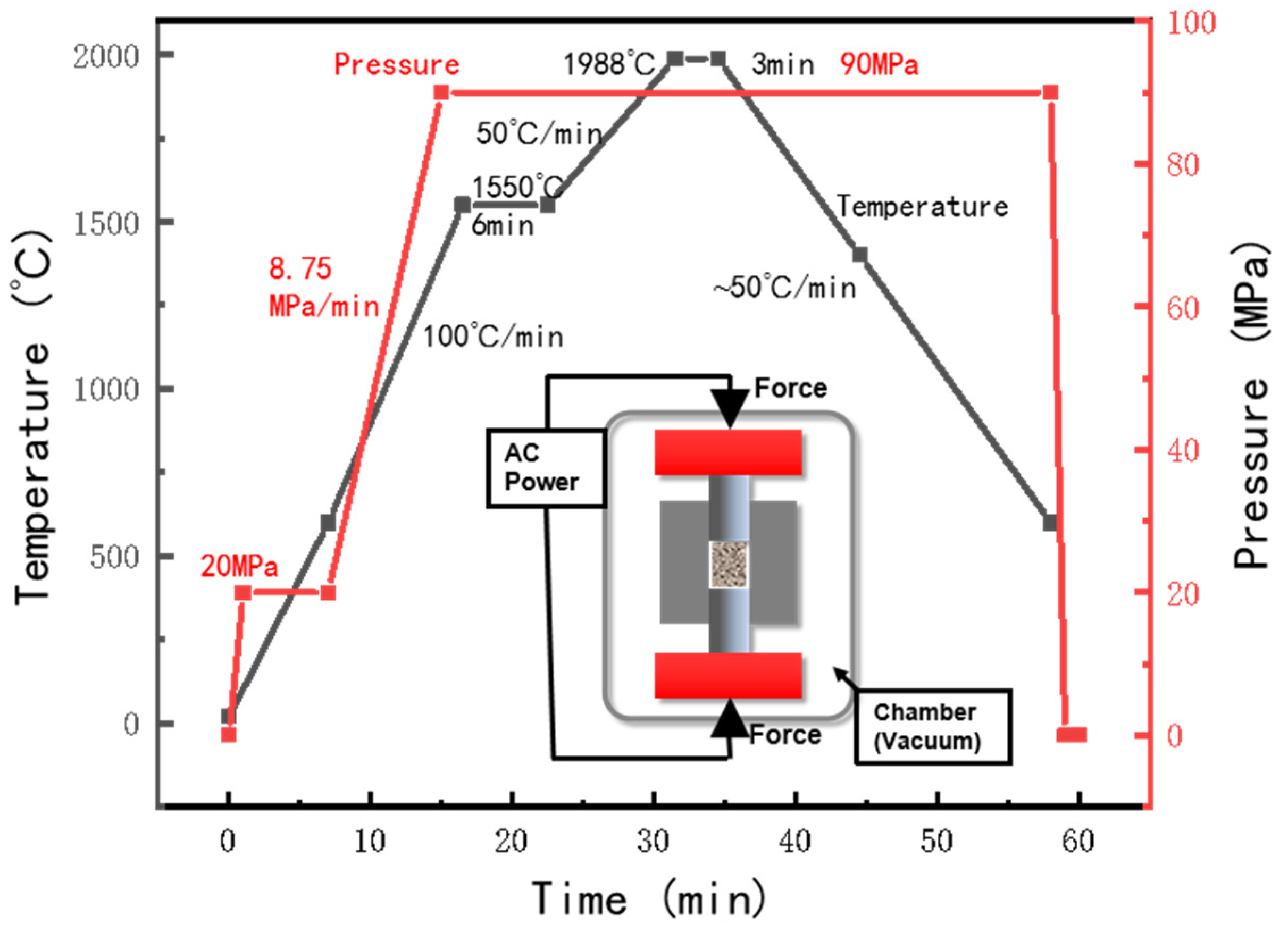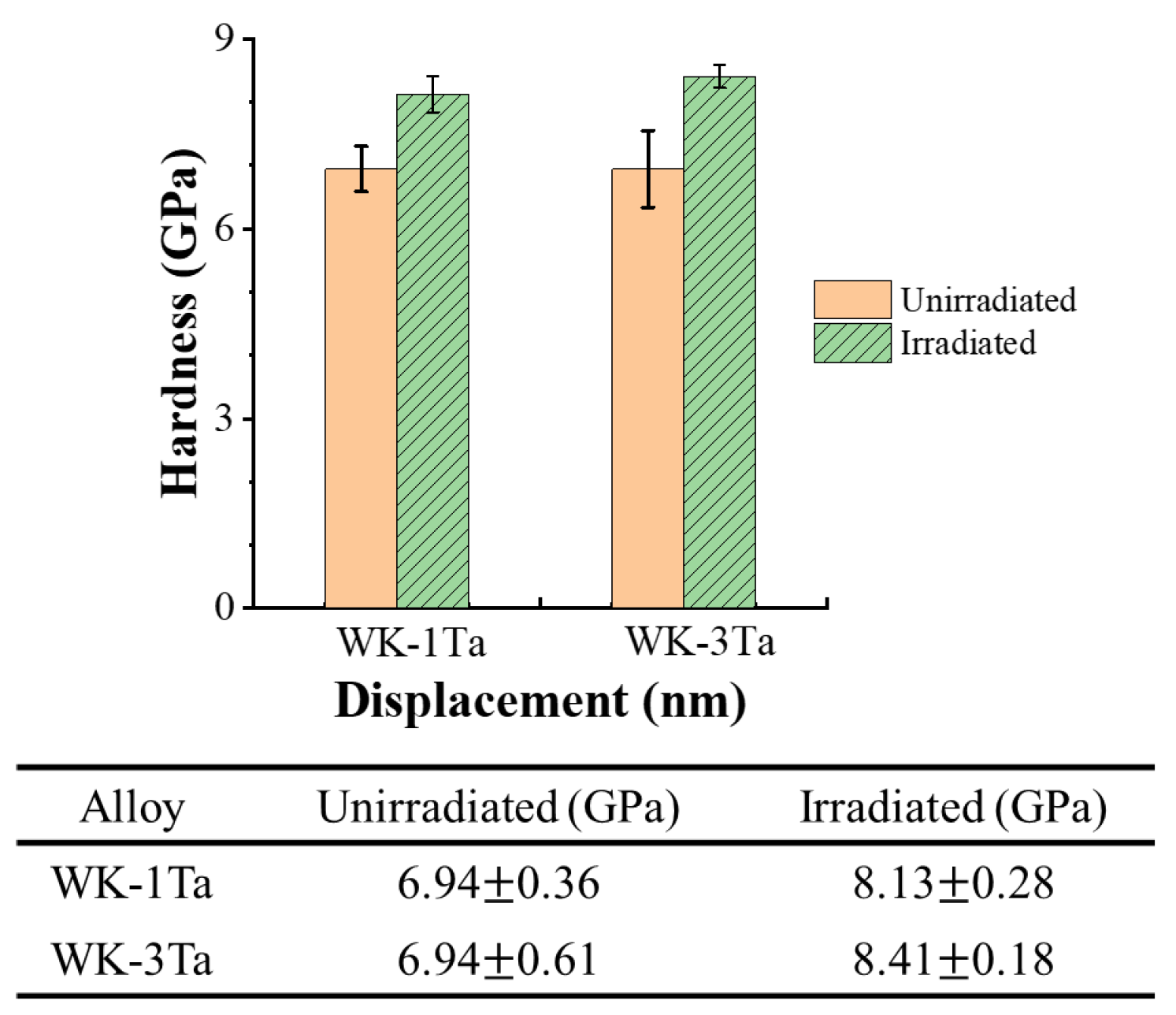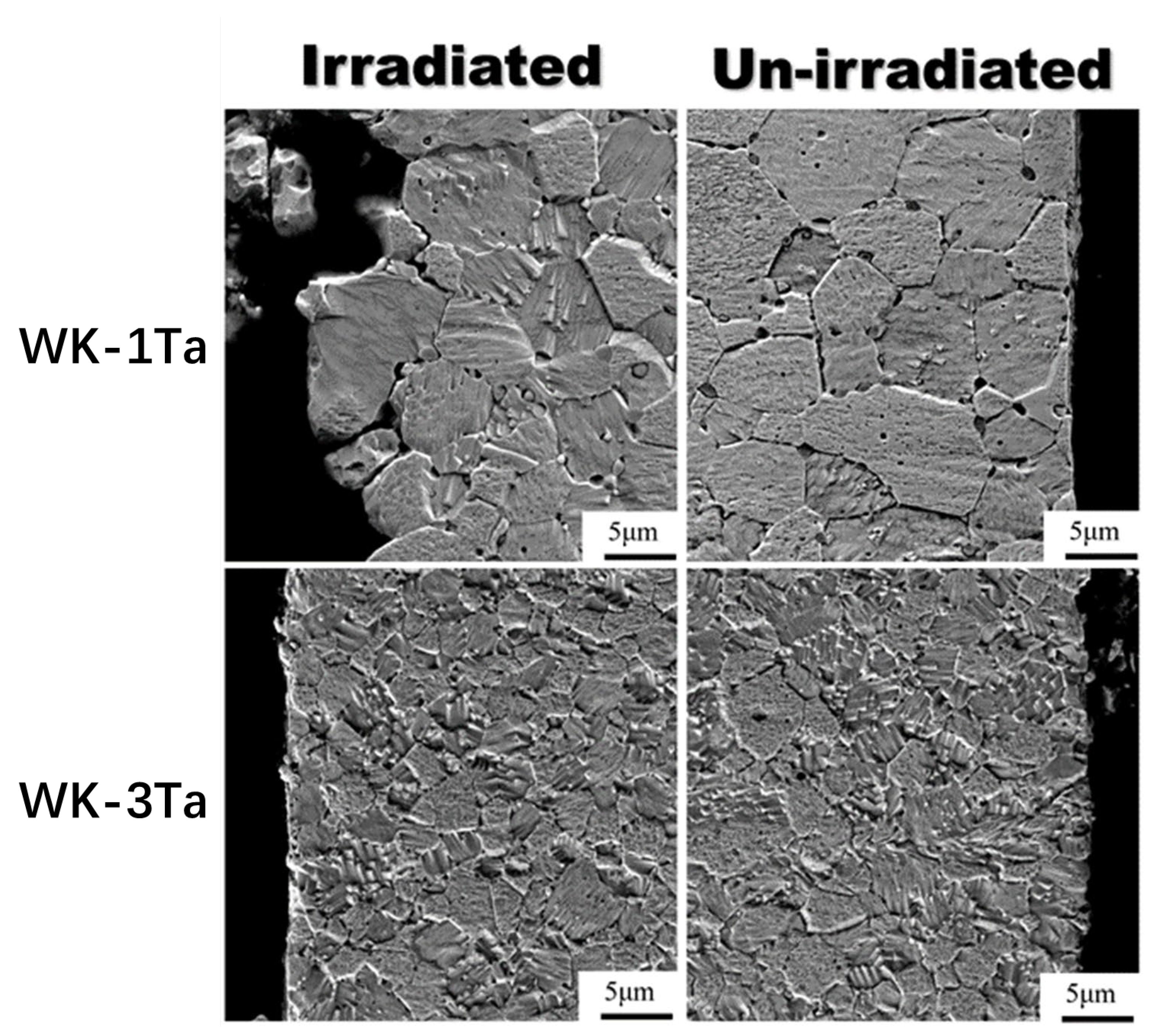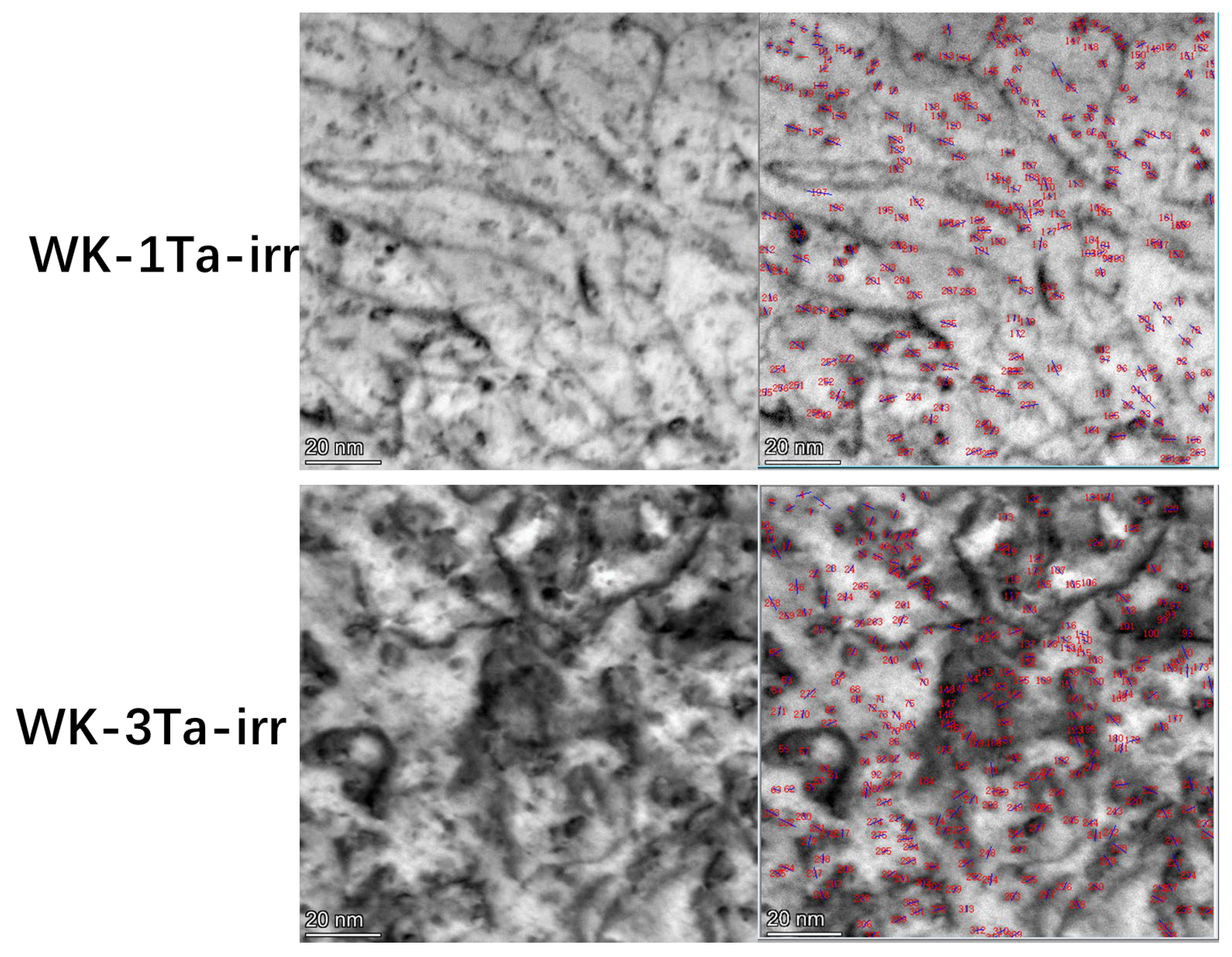Properties of Potassium Doped and Tantalum Containing Tungsten after Heavy Ion Irradiation
Abstract
1. Introduction
2. Materials and Methods
3. Results
3.1. Density and Grain Size
3.2. Microstructure and Element
3.3. Vcikers Hardness and Nano Hardness
4. Discussion
5. Conclusions
Author Contributions
Funding
Data Availability Statement
Conflicts of Interest
References
- Linsmeier, C.; Rieth, M.; Aktaa, J.; Chikada, T.; Hoffmann, A.; Houben, A.; Kurishita, H.; Jin, X.; Li, M.; Litnovsky, A.; et al. Development of advanced high heat flux and plasma-facing materials. Nucl. Fusion 2017, 57, 092007. [Google Scholar] [CrossRef]
- Visca, J.H.Y.; Crescenzi, C.B.B.; Fursdon, M.; Greuner, H.; Guilhem, D.; Languille, P.; Li, M.; McIntosh, S.; Müller, A.V.; Reiser, J.; et al. European DEMO divertor target: Operational requirements and material-design interface. Nucl. Mater. Energy 2016, 9, 171–176. [Google Scholar]
- Coenen, J.W.; Antusch, S.; Aumann, M.; Biel, W.; Du, J.; Engels, J.; Heuer, S.; Houben, A.; Hoeschen, T.; Jasper, B.; et al. Materials for DEMO and reactor applications boundary conditions and new concepts. Phys. Scr. 2016, T167, 014002. [Google Scholar] [CrossRef]
- Tanure, L.; Terentyev, D.; Nikoli, V.; Riesch, J.; Verbeken, K. EBSD characterization of pure and K-doped tungsten fbers annealed at different temperatures. J. Nucl. Mater. 2020, 537, 152201. [Google Scholar] [CrossRef]
- Huang, B.; Chen, L.; Qiu, W.; Yang, X.; Shi, K.; Lian, Y.; Liu, X.; Tang, J. Correlation between the microstructure, mechanical/thermal properties, and thermal shock resistance of K-doped tungsten alloys. J. Nucl. Mater. 2019, 520, 6–18. [Google Scholar] [CrossRef]
- Huang, B.; Tang, J.; Chen, L.; Yang, X.; Lian, Y.; Chen, L.; Liu, X.; Cui, X.; Gu, L.; Liu, C. Design of highly thermal-shock resistant tungsten alloys with nano scaled intra- and inter-type K bubbles. J. Alloys Compd. 2019, 782, 149–159. [Google Scholar] [CrossRef]
- Ma, X.; Zhang, X.; Wang, T.; Lang, S.; Lv, W.; Wang, Y.; Ge, C.; Yan, Q. Large-scale potasium-doped tungsten alloy with superior recrystallization resistance, ductility and strength induced by potassium bubbles. J. Nucl. Mater. 2022, 559, 153450. [Google Scholar] [CrossRef]
- Ma, X.; Wang, T.; Zhang, X.; Yuan, Y.; Cheng, L.; Zhu, J.; Lv, W.; Lang, S.; Wang, Z.; Ge, C.; et al. Surface modification and deuterium retention in hot-rolled potassium doped tungsten alloy exposed to deuterium plasma. J. Nucl. Mater. 2022, 568, 153890. [Google Scholar] [CrossRef]
- Ma, X.; Zhang, X.; Wang, T.; Lv, W.; Lang, S.; Ge, C.; Yan, Q. Irradiation hardening behaviors of large-scale hot rolling potassium-doped tungsten alloy under synergistic irradiations of Fe11+ ion combined with deuterium and helium plasmas. Nucl. Mater. Energy 2022, 30, 101138. [Google Scholar] [CrossRef]
- Ishijima, Y.; Kurishita, H.; Yubuta, K.; Arakawa, H.; Hasegawa, M.; Hiraoka, Y.; Takida, T.; Takebe, K. Current status of ductile tungsten alloy development by mechanical alloying. J. Nucl. Mater. 2004, 329–333, 775–779. [Google Scholar] [CrossRef]
- Watanabe, S.; Nogami, S.; Reiser, J.; Rieth, M.; Sickinger, S.; Baumgärtner, S.; Miyazawa, T.; Hasegawa, A. Tensile and impact properties of tungsten-rhenium alloy for plasma-facing components in fusion reactor. Fusion Eng. Des. 2019, 148, 111323. [Google Scholar] [CrossRef]
- Liu, X.; Lian, Y.; Greuner, H.; Boeswirth, B.; Jin, Y.; Feng, F.; Wang, J.; Chen, L.; Song, J.; Yu, Y.; et al. Irradiation effects of hydrogen and helium plasma on different grade tungsten materials. Nucl. Mater. Energy 2017, 12, 1314–1318. [Google Scholar] [CrossRef]
- Chen, L.; Li, S.; Qiu, W.; Huang, B.; Lian, Y.; Liu, X.; Tang, J. Combining the K-bubble strengthening and Y-doping: Microstructure, mechanical/thermal properties, and thermal shock behavior of W-K-Y alloys. Int. J. Refract. Met. Hard Mater. 2022, 103, 105739. [Google Scholar] [CrossRef]
- Wang, Z.; Yuan, Y.; Arshad, K.; Wang, J.; Zhou, Z.; Tang, J.; Lu, G.H. Effects of tantalum concentration on the microstructures and mechanical properties of tungsten-tantalum alloys. Fusion Eng. Des. 2017, 125, 496–502. [Google Scholar] [CrossRef]
- Zhou, H.; Yu, J.; Chen, C.; Zhu, K. Effect of pre-damage induced by argon ions on the deuterium blister formation in tungsten-tantalum alloys exposed to deuterium plasma. Int. J. Hydrog. Energy 2019, 44, 23320–23329. [Google Scholar] [CrossRef]
- Roth, J.; Tsitrone, E.; Loarte, A.; Loarer, T.; Counsell, G.; Neu, R.; Philipps, V.; Brezinsek, S.; Lehnen, M.; Coad, P.; et al. Recent analysis of key plasma wall interactions issues for ITER. J. Nucl. Mater. 2009, 390–391, 1–9. [Google Scholar] [CrossRef]
- Ueda, Y.; Coenen, J.W.; de Temmerman, G.; Doerner, R.P.; Linke, J.; Philipps, V.; Tsitrone, E. Research status and issues of tungsten plasma facing materials for ITER and beyond. Fusion Eng. Des. 2014, 89, 901–906. [Google Scholar] [CrossRef]
- Zinkle, S.J.; Snead, L.I. Designing radiation resistance in materials for fusion. Annu. Rev. Mater. Res. 2014, 44, 241–267. [Google Scholar] [CrossRef]
- Bolt, H.; Barabash, V.; Federici, G.; Linke, J.; Loarte, A.; Roth, J.; Sato, K. Plasma facing and high heat flux materials—Needs for ITER and beyond. J. Nucl. Mater. 2002, 307–311, 43–52. [Google Scholar] [CrossRef]
- Bolt, H.; Barabash, V.; Krauss, W.; Linke, J.; Neu, R.; Suzuki, S.; Yoshida, N. Materials for the plasma-facing components of fusion reactors. J. Nucl. Mater. 2004, 329–333, 66–73. [Google Scholar] [CrossRef]
- Nogami, S.; Terentyev, D.; Zinovev, A.; Yin, C.; Rieth, M.; Pintsuk, G.; Hasegawa, A. Neutron irradiation tolerance of potassium-doped and rhenium-alloyed tungsten. J. Nucl. Mater. 2021, 553, 153009. [Google Scholar] [CrossRef]
- Fukuda, M.; Hasegaw, A.; Tanno, T.; Nogami, S.; Kurishita, H. Property change of advanced tungsten alloys due to neutron irradiation. J. Nucl. Mater. 2013, 442, S273–S276. [Google Scholar] [CrossRef]
- Stoller, R.E.; Toloczko, M.B.; Was, G.S.; Certain, A.G.; Dwaraknath, S.; Garner, F.A. On the use of SRIM for computing radiation damage exposure. Nucl. Instrum. Methods Phys. Res. Sect. B Beam Interact. Mater. At. 2013, 310, 75–80. [Google Scholar] [CrossRef]
- Tejado, E.; Carvalho, P.A.; Munoz, A.; Dias, M.; Correia, J.B.; Mardolcar, U.V. The effects of tantalum addition on the microtexture and mechanical behaviour of tungsten for ITER applications. J. Nucl. Mater. 2015, 467, 949–955. [Google Scholar] [CrossRef]
- Wen, P.; Hu, X.; Fan, C.; Tan, Y.; Qiu, W.; Zhao, T.; Li, S.; Wu, C.; Du, J.; Tang, J. Irradiation hardening of WK-based PFM exposed to 14 MeV protons. Fusion Eng. Deign 2023, 187, 113379. [Google Scholar] [CrossRef]
- Garrison, L.M.; Katoh, Y.; Snead, L.L.; Byun, T.S.; Reiser, J.; Rieth, M. Irradiation effects in tungsten-copper laminate composite. J. Nucl. Mater. 2016, 481, 134–146. [Google Scholar] [CrossRef]
- Dellis, S.; Xiao, X.; Terentyevc, D.; Mergiaa, K.; Krimpalis, S.; Bakaev, A.; Messoloras, S. Mechanical properties of neutron-irradiated single crystal tungsten W(100) studied by indentation and FEM modelling. J. Nucl. Mater. 2021, 551, 152985. [Google Scholar] [CrossRef]
- Yang, X.L.; Chen, L.Q.; Qiu, W.B.; Song, Y.Y.P.; Tang, Y.; Cui, X.D.; Liu, C.S.; Jiang, Y.; Zhang, T.; Tang, J. Irradiation hardening behaviors of tungsten-potassium alloy studied by accelerated 3-MeVW2+ ions. Chin. Phys. B 2020, 29, 046102. [Google Scholar] [CrossRef]
- Song, Y.Y.P.; Qiu, W.B.; Chen, L.Q.; Yang, X.L.; Deng, H.; Liu, C.S.; Zhang, K.; Tang, J. Hardening effect of multi-energy W2+-ion irradiation on tungsten–potassium alloy. Chin. Phys. B 2020, 29, 105202. [Google Scholar] [CrossRef]










| Particle Size, μm | Element Content (ppm) | Oxygen Content (wt. %) | |||||||||||||
|---|---|---|---|---|---|---|---|---|---|---|---|---|---|---|---|
| K | Al | Si | Na | Fe | Ca | Cu | Ti | Mo | Ni | Co | N | S | C | ||
| 3.28 | 82 | 30 | 185 | <1 | 28 | <5 | <1 | <5 | <5 | 4 | 4 | 13 | <10 | <10 | 0.1 |
| Particle Size, μm | Element Content (wt. %) | |||||||||||||
|---|---|---|---|---|---|---|---|---|---|---|---|---|---|---|
| Al | Fe | Ca | Mg | Cu | Mn | Na | Co | Ni | Si | P | K | S | C | |
| 10.5 | 0.004 | 0.018 | 0.004 | 0.001 | 0.001 | 0.001 | 0.002 | 0.001 | 0.001 | 0.004 | 0.003 | 0.002 | 0.004 | 0.005 |
| HV0.2 1.96 N, 15 s | Location 1 | Location 2 | Location 3 | Average |
|---|---|---|---|---|
| WK-1Ta | 404.2 | 433.8 | 398.1 | 412.0 ± 19.1 |
| WK-3Ta | 496.0 | 520.0 | 510.0 | 508.7 ± 12.1 |
| WK-1Ta-irr | 406.3 | 414.2 | 422.9 | 414.5 ± 8.3 |
| WK-3Ta-irr | 517.3 | 536.8 | 501.1 | 518.4 ± 17.9 |
Disclaimer/Publisher’s Note: The statements, opinions and data contained in all publications are solely those of the individual author(s) and contributor(s) and not of MDPI and/or the editor(s). MDPI and/or the editor(s) disclaim responsibility for any injury to people or property resulting from any ideas, methods, instructions or products referred to in the content. |
© 2023 by the authors. Licensee MDPI, Basel, Switzerland. This article is an open access article distributed under the terms and conditions of the Creative Commons Attribution (CC BY) license (https://creativecommons.org/licenses/by/4.0/).
Share and Cite
Du, J.; Wu, C.; Zhao, T.; Wen, P.; Wang, P.; Tang, J.; Liu, X.; Chen, J. Properties of Potassium Doped and Tantalum Containing Tungsten after Heavy Ion Irradiation. Crystals 2023, 13, 951. https://doi.org/10.3390/cryst13060951
Du J, Wu C, Zhao T, Wen P, Wang P, Tang J, Liu X, Chen J. Properties of Potassium Doped and Tantalum Containing Tungsten after Heavy Ion Irradiation. Crystals. 2023; 13(6):951. https://doi.org/10.3390/cryst13060951
Chicago/Turabian StyleDu, Juan, Chuan Wu, Tianyu Zhao, Pan Wen, Pinghuai Wang, Jun Tang, Xiang Liu, and Jiming Chen. 2023. "Properties of Potassium Doped and Tantalum Containing Tungsten after Heavy Ion Irradiation" Crystals 13, no. 6: 951. https://doi.org/10.3390/cryst13060951
APA StyleDu, J., Wu, C., Zhao, T., Wen, P., Wang, P., Tang, J., Liu, X., & Chen, J. (2023). Properties of Potassium Doped and Tantalum Containing Tungsten after Heavy Ion Irradiation. Crystals, 13(6), 951. https://doi.org/10.3390/cryst13060951





